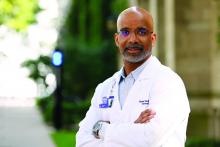Percutaneous coronary intervention (PCI) with optimal medical therapy (OMT) does not prolong survival or improve ventricular function, compared with OMT alone, in patients with severe ischemic cardiomyopathy, according to results from the REVIVED-BCIS2 trial.
The primary composite outcome of all-cause death or heart failure hospitalization occurred in 37.2% of the PCI group and 38% of the OMT group (hazard ratio, 0.99; P = .96) over a median of 3.4 years follow-up. The treatment effect was consistent across all subgroups.
There were no significant differences in left ventricular ejection fraction (LVEF) at 6 and 12 months.
Quality of life scores favored PCI early on, but there was catch-up over time with medical therapy, and this advantage disappeared by 2 years, principal investigator Divaka Perera, MD, King’s College London, reported at the annual congress of the European Society of Cardiology.
“The takeaway is that we should not be offering PCI to patients who have stable, well-medicated left ventricular dysfunction,” Dr. Perera told this news organization. “But we should still consider revascularization in patients presenting with acute coronary syndromes or who have lots of angina, because they were not included in the trial.”
The study, published simultaneously in the New England Journal of Medicine, provides the first randomized evidence on PCI for ischemic cardiomyopathy.
Revascularization guidelines in the United States make no recommendation for PCI, whereas those in Europe recommend coronary artery bypass grafting (CABG) first for patients with multivessel disease (class 1); they have a class 2a, level of evidence C indication for PCI in select patients. U.S. and European heart failure guidelines also support guideline directed therapy and CABG in select patients with ejection fractions of 35% or less.
This guidance is based on consensus opinion and the STICH trial, in which CABG plus OMT failed to provide a mortality benefit over OMT alone at 5 years but improved survival at 10 years in the extension STICHES study.
“Medical therapy for heart failure works, and this trial’s results are another important reminder of that,” said Eric Velazquez, MD, who led STICH and was invited to comment on the findings.
Mortality will only get better with the use of SGLT2 inhibitors, he noted, which were not included in the trial. Utilization of ACE inhibitors/ARBs/ARNIs and beta-blockers was similar to STICH and excellent in REVIVED. “They did do a better job in utilization of ICD and CRTs than the STICH trial, and I think that needs to be explored further about the impact of those changes.”
Nevertheless, ischemic cardiomyopathy patients have “unacceptably high mortality,” with the observed mortality about 20% at 3 years and about 35% at 5 years, said Dr. Velazquez, with Yale University, New Haven, Conn.
In most heart failure trials, HF hospitalization drives the primary composite endpoint, but the opposite was true here and in STICH, he observed. “You had twice the risk of dying during the 3.4 years than you did of being hospitalized for heart failure, and ... that is [an important] distinction we must realize is evident in our ischemic cardiomyopathy patients.”
The findings will likely not lead to a change in the guidelines, he added. “I think we continue as status quo for now and get more data.”
Despite the lack of randomized evidence, he cautioned that PCI is increasingly performed in patients with ischemic cardiomyopathy, with registry data suggesting nearly 60% of patients received the procedure.
Reached for comment, Clyde Yancy, MD, chief of cardiology and vice dean of diversity & inclusion at Northwestern University Feinberg School of Medicine, Chicago, said, “For now, the current guidelines are correct. Best application of guideline-directed medical and device therapy is the gold standard for heart failure, and that includes heart failure due to ischemic etiologies.
“Do these data resolve the question of revascularization in the setting of coronary disease and reduced EF heart failure? Hardly,” he added. “Clinical judgment must prevail, and where appropriate, coronary revascularization remains a consideration. But it is not a panacea.”

